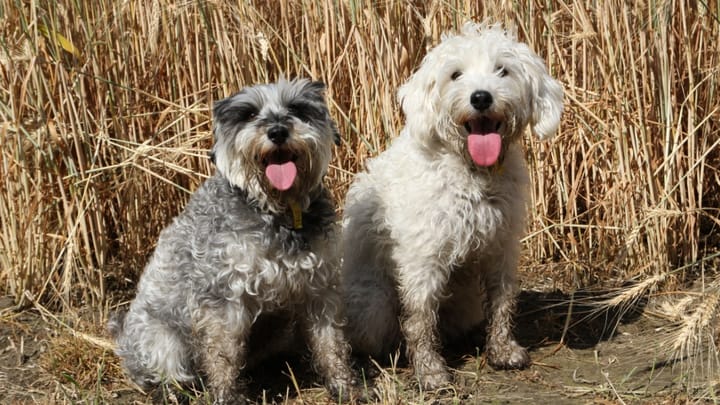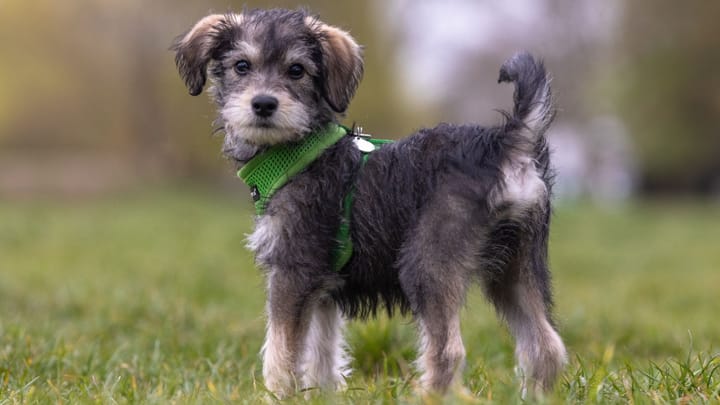Schnoodle
Crossbreed: Schnauzer × Poodle


The Schnoodle is a cross between a Schnauzer and a Poodle. Schnoodles have become increasingly popular in recent years, thanks to their adorable appearance and loving nature. Schnoodles combine characteristics from both parent breeds: They are energetic, loyal, affectionate and intelligent. Schnoodles typically make wonderful family companions. Their high activity levels make them more suitable for active owners, who are looking for a playful, outgoing four-legged friend.
Schnauzers are balanced dogs, though they also have strong personalities. They are very attached to their owners and family members. They feel very protective of children and are wary of strangers. There are three varieties: toy, standard, and giant. Schnauzers make good guard dogs because they are courageous and vigilant.
The Poodle comes in four sizes (toy, miniature, medium and standard) and five different coat colours (black, white, grey, brown or apricot). They are very intelligent dogs who, despite their misleadingly fragile appearance, are actually very robust and resilient. Cheerful, playful, lovable and affectionate, Poodles can adapt to many different lifestyles.

Schnauzer
Schnauzers are balanced dogs, though they also have strong personalities. They are very attached to their owners and family members. They feel very protective of children and are wary of strangers. There are three varieties: toy, standard, and giant. Schnauzers make good guard dogs because they are courageous and vigilant.

Poodle
The Poodle comes in four sizes (toy, miniature, medium and standard) and five different coat colours (black, white, grey, brown or apricot). They are very intelligent dogs who, despite their misleadingly fragile appearance, are actually very robust and resilient. Cheerful, playful, lovable and affectionate, Poodles can adapt to many different lifestyles.
|
Life expectancy |
The Schnoodle has a life expectancy of between 10 and 15 years |
|
Temperament |
|
|
Size |
Medium
|
|
Adult size |
Female
Between 11 and 26 in
Male
Between 11 and 26 in
|
|
Adult weight |
Female
Between 15 and 77 lb
Male
Between 15 and 77 lb
|
|
Coat colour
|
Black White Brown |
|
Type of coat
|
Long Wavy |
|
Eye colour
|
Brown
|
|
Purchase price |
The Schnoodle costs between £1000 and £2000 |
Due to the variety of sizes of the Schnoodle parent breeds, Schnoodles can also come in different sizes: toy, standard, and giant.
More details about the Schnoodle
Schnoodle: Origins and history
The first Schnoodle breeding attempts took place in Minnesota, United States, in the 1980s.
The crossbreed has gained popularity due to its intelligence, friendly nature and beautiful coat. Schnoodles are active, intelligent, and easy-to-train dogs, making them great companions for families. Schnoodles can have a wide variety of coat colours, textures, and lengths, depending on the coat type they inherit from the Schnauzer and Poodle parents.
Schnoodle: Characteristics
Schnoodle: Behaviour
Training a Schnoodle
Due to their intelligence and eagerness to please, Schnoodles are generally easy to train and obedient. They can be stubborn at times and respond best to positive reinforcement training.
Schnoodle: Lifestyle
Breed compatibility Schnoodle
Schnoodle: Purchase price
Schnoodles typically cost between £1,000 to £2,000, depending on location and breeder.
In addition to the initial cost, you will need to factor in monthly expenses for food, veterinary care, accessories and insurance.
Schnoodle: Shedding
Light
Schnoodles inherit the hypoallergenic coat of the Poodle and the low shedding coat of the Schnauzer. This makes this crossbreed the ideal choice for allergy sufferers.
Schnoodle: Grooming
Grooming a Schnoodle is essential to maintaining a healthy coat. You will need to brush your Schnoodle two to three times a week to prevent mats and tangles. Schnoodles also require a trip to the groomer every 6 to 8 weeks, in addition to checking their ears and nails regularly to prevent infections and discomfort.
Schnoodle: Health
Schnoodles are generally fairly robust dogs, but they can inherit health issues from their parent breeds.
Schnoodles tolerate heat moderately well, but like all dogs, precautions should be taken to avoid heat stroke in summer.
Schnoodles tolerate cold weather fairly well, but they may need warm clothing or proper shelter in winter, especially if they're small.
Schnoodles can have a tendency to gain weight, especially if they're not exercised enough. A balanced diet and regular exercise are essential to prevent weight gain and obesity.
Schnoodles can be prone to certain health conditions, some of which may be genetic. For example, excessive ear hair production is a common problem among both parent breeds, requiring regular maintenance by a veterinarian to prevent infections. Other potential health problems include epilepsy, diabetes, and eye disorders.






